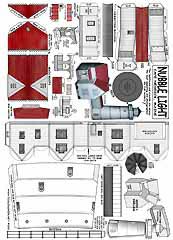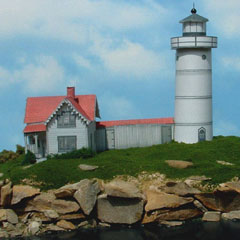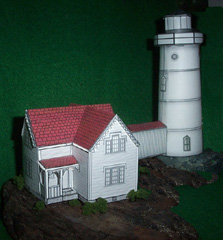
Cape Neddick, ME - $$4.95
The Cape Neddick (Nubble) lighthouse and grounds are among the most appealing and photographed in the world with an estimated 250,00 visitors annually. Historically, this lighthouse has been important in keeping vessels away from the rocky stretch of coast between Portsmouth, New Hampshire, to the south and Portland, Maine, to the north.
Cape Neddick (Nubble) Light House York, Maine

The Cape Neddick (Nubble) lighthouse and the surrounding grounds are among the most appealing and photographed in the world with an estimated 250,00 visitors annually. Historically, this lighthouse has been important in keeping vessels away from the rocky stretch of coast between Portsmouth, New Hampshire, to the south and Portland, Maine, to the north.
Perched high on the small, rocky island (the nubble) the Keepers house with lovely gingerbread trim under the eves, is a six room Victorian built in the shape of a cross with the points lining up north, south, east and west. In 1977 NASA sent Voyager 11 spacecraft into space with items aboard designed to teach extraterrestrial civilizations about our planet and a picture of the Nubble Light was among the images included.
Three scales of the Nubble Lighthouse are included in the Nubble Lighthouse folder. (Shown is the "N" scale version)
Cape Neddick Light House
A lighthouse on the small, rocky island (the nubble) off the
eastern point of Cape Neddick, had been recommended by local mariners
since 1807, but it wasn't until seventy years later that the lighthouse
was established.The 41 -foot cast-iron tower was authorized by
President Rutherford B. Hayes and first illuminated in July 1879.
Although initially painted red, the tower has been white since
1902. The distinctive red oil house was built in 1902 and the
walkway connecting the keeper's house and tower added in 1911.
The station originally had a fog bell and bell tower; this structure was razed in 1961. An 1891 fourth-order lens, although not the original, still is in use. A bucet suspended on a line across the channel was used to transport supplies to the station; the conveyance is similarly used today for maintenance equipment. Unique to this light tower are the miniature cast-iron lighthouses atop the posts on the railing surrounding the lantern room.
Also distinguishing Cape Neddick Light was a past feline resident who, at 19 pounds, reportedly attracted as many interested tourists as did the lighthouse itself. The cat allegedly was the best mouser in Maine, regularly swimming the channel to visit briefly with mainland friends, then returning to the lighthouse to deal with the mice.
Cape Neddick Light was automated in 1987; the Town of York now manages the surrounding property, having received more than 300 unsolicited offers from people wanting to be live-in caretakers. Some restoration work has been done with an 1989 grant from the Maine Historic Preservation Committee. Two small second story windows were replaced with one large window to restore the original appearance of the house.
The nearby communities of York and Kennebunkport have grown into some of the wealthiest enclaves in America. The Town of York sponsors periodic excursions to the island during the summer allowing visitors to tour the tower and keeper's house.

Prior to 1961 the fog signal was a 1200 pound bronze bell which keepers had to hand wind. This bell had to be activated in all kinds of foul weather. If the striker mechanism wasn't working and foul weather had set in the keeper, or any visitors on the island would have to sit on a box next to the bell and hit it with a hammer. This had to be done every ten to fifteen seconds until the signal would be back in operation.
Getting a good supply of fresh water has always been a problem at most light stations. The answer to water needs was to catch rain water, store it and use it. The Nubble was no exception. Rain water running off the roof was collected by down spouts and held in a 4,000 gallon tank in the cellar of the main house. Keepers did pray for rain. The first water running down the roof carried with it all types of contamination. This included sea gull and other bird droppings. Cups were placed upside down in the down spouts which would stop the first rush of water.
When the keeper felt the contamination was washed out, the cups were turned over to allow the rest of the storm water to enter the tanks. Baths were few and far between especially during a dry season. Keepers had to constantly check on the purity of the water. The tanks were periodically scrubbed with bleach. The toilet systems were all salt water flushed.
 |
 |
|
|
|



